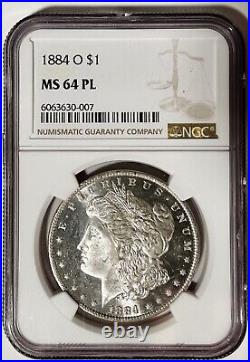
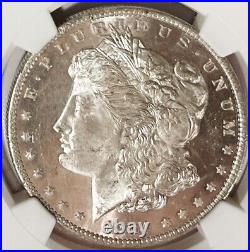
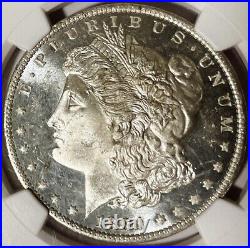
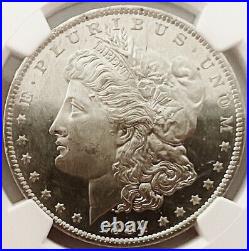
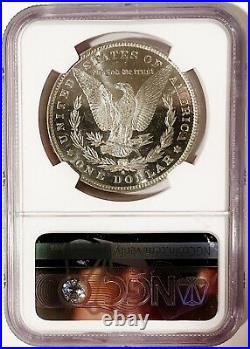
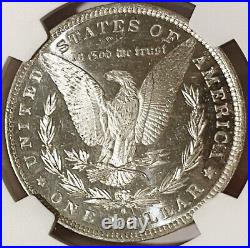
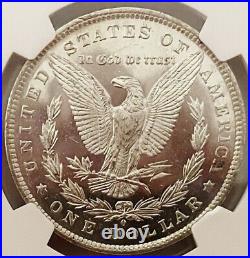

Great feedback – check out some of the recent feedback. We’ve received from our customers. An absolutely amazing coin for a more than fair price – perfectly described! Brilliant communication and fantastic customer service! To Do Business With. One of the Best and Most Honest Sellers! And thank you to ALL of our customers for allowing us to serve you with quality coins, accurate and honest descriptions and photos, and above-and-beyond service. Your satisfaction will always be our No. An 1884-O/O Morgan Dollar certified MS64PL. Though not listed on the label, this coin is unquestionably a VAM 11, featuring an easily seen (with a loupe) re-punched mint mark, a doubled 18 and an unusual spit of metal jutting from the left bottom serif of the “1”. This coin features a solid proof-like profile, with a lustrous cameo, relatively little chatter and a well-above-average strike. Obverse contrast is not as sharp or as noticeable as the photos indicate (typical of PL and DMPL photos), and while there certainly is contrast, it’s below average. The reverse contrast, on the other hand, is outstanding and definitely ranks as black-and-white. The reverse mirrors are probably DMPL, reflecting a good 8 to 10 inches out from the coin. Chatter is typical of a top-end Choice coin, with some swirl chatter and a few runs and marks in the fields and a handful of contact marks and runs on Liberty. The only chatter that stands out in any way is the mark on Liberty’s cheek but while visible, it is not really distracting in hand. And don’t forget to check out our other listings. Thank you for your continued support of Shenandoah. Don’t like your item? Found a better price? Run it through the wash? Eh, yeah, that would be a problem. But almost anything else – that’s right, no problem. Thank you for reading and for looking at our items. Upon its release in 1878, there was little evidence the Morgan Dollar would be anything but an embarrassing footnote in the world of numismatics. Its design was criticized by most coin connoisseurs and the public alike, and it remained unpopular throughout its production run, which stopped in 1904 before being brought back for a single year in 1921. Despite these humble beginnings, however, the Morgan dollar has grown to become the most popular U. Collectible coin in history. And no version of the Morgan Dollar is as popular as the deep mirror proof-like, or DMPL. With blast-white cameos, sharp black-and-white contrast and deep crystal-clear mirrors, it’s easy to see why DMPLs and, to a lesser extent, the proof-like, or PL, Morgan are the most sought-after in the series. Unfortunately, they are also among the hardest to photograph. A couple of important things to remember right off the bat. Cameos and contrast will always look brighter, whiter and sharper in photos – whether they’ve been manipulated or not. While this isn’t the case with every DMPL listing, it is, to one degree or another, with a majority of them. Most of the time, that’s not the case. The difference between a Morgan’s appearance in photos and in hand is simply a product of the camera’s tendency to exaggerate the DMPL’s defining features, and the fact that most photos are close-ups, which naturally make the coin look three, four or five times bigger than it is. By definition, that will exaggerate everything about it, including its attributes. That makes it a challenge for ethical sellers to take photos that don’t make their coins look much better than they are, while still giving prospective buyers a good look at its best points. It also makes a listing’s description all the more important. In most cases, an out of the way bag mark or imperceptible run that can’t be seen in photos won’t affect eye appeal or the coin’s value. But if there’s something that’s especially noticeable in hand that the photos aren’t showing – or if they’re significantly exaggerating contrast or cameo thickness, for instance – that really should be mentioned. The Doctors Are In. So be on the lookout for those as well. The good news is they’re not hard to spot if you know what to look for. Another red flag to watch for are sellers who shoot all of their coins from the same angle and use lighting that always highlights the same part of the coin, usually with Liberty getting the spotlight from a powerful, off-camera light source. The light is usually angled in such a way to make cameos look much whiter and/or brighter than they are. Those will give you a more comprehensive look at a coin’s various features, good and bad. The same holds true for coins shot only in shadow. Such photos will often hide most, if not all, of a coin’s defects, including bag marks, runs, scratches, hairlines, and uneven tone an indication a coin may have been cleaned. Don’t be afraid to ask for additional photos, specifying you’d like to see those taken in both light and shadow, and, preferably, at different angles. Remember, you’re the customer. Then you have bait-and-switch (BAS) sellers. The bait-and-switch works like this. Now I know what you’re thinking. How do I know the sale of that pristine coin wasn’t canceled for some reason? Fair points — and sometimes you can’t know for sure. But a little investigation will often confirm the BAS is on. When you get the results, check the photos against those in the active listing. If they’re the same, you may well have a BAS. So now you know the BAS is on and the coin in the photos is not the one the winner will get. Naturally, that information is nowhere to be found in the listing. Super – and Super Absurd. Perhaps the easiest red flag to spot is the overhyped listing title. Now there’s nothing wrong with a title – or a listing description for that matter – that plays up a coin’s attributes. After all, I want to get as many buyers as possible to look at my coins. What I don’t want, however, is to exaggerate to the point of deception. So how do you tell the difference between the eager yet still ethical sellers and those who will say anything, truthful or not, to make a sale? Some sellers in this category may be listing all of their coins with a single title simply out of convenience or to save time. But in many cases — particularly those in listings that also have photos showing impossibly perfect coins — it crosses a line from legitimate time-saver to outright deception. Then there are the sellers that do nothing but string together a bunch of superlatives. If a coin is listed as being a Mega-Monster-Sweet-Turbo. , you might want to think twice. I mean, are we talking about sports cars here or silver dollars? Remember, the overhyped titles often go hand-in-hand with the manipulated photos, but not always. Sometimes you’ll find sellers who take care to describe their coins more or less accurately in the titles and listings, but who post ginned-up photos. A Word About Feedback. Collectibles in general, and coins in particular, are among the categories in which buyers are more reluctant to leave negatives. There are a couple of reasons for this. The quality and value of collectibles are subjective, to say the least, and buyers know that opinions will often vary. They’re reluctant to tag someone with a negative in cases where a return or dispute might have come down to nothing more than an honest disagreement. That comes with the territory. And remember, the opposite is also true. All that said, dishonest sellers might still have some very nice coins among their listings. But don’t be surprised if that silver dollar listing with photos showing a porcelain-like cameo and the patently absurd claim of “30 inch mirrors” turns out to have a very weak cameo and mirrors that are only PL, if that. The bottom line: it’s a crap shoot, at best. You might get a nice coin. But either way, you almost certainly won’t get one that looks anything close to what the photos show – and you probably will have overpaid for the coin, no matter how nice it is. Sure, but this is not a sales pitch, I assure you. And I’m certainly not trying to bash the competition for the simple fact that I don’t have any. I sell 3 or 4 coins a week as a side business — though calling it a “business” is a stretch. It’s mostly an extension of my love for coin collecting, which has been a hobby of mine for as long as I can remember. They don’t affect my business any more than I affect theirs. There are plenty of honest and respectful sellers who deserve your time and business. This item is in the category “Coins & Paper Money\Coins: US\Dollars\Morgan (1878-1921)”. The seller is “shenandoah.blue” and is located in this country: US. This item can be shipped worldwide.
- Country/Region of Manufacture: United States
- Coin: Morgan
- Fineness: 90%
- Certification: NGC
- Strike Type: Proof-Like
- Mint Location: New Orleans
- Grade: MS 64
- Year: 1884
- Circulated/Uncirculated: Uncirculated
- Composition: Silver
- Denomination: $1
